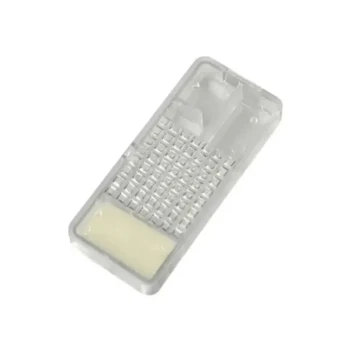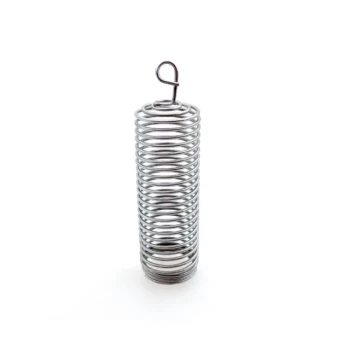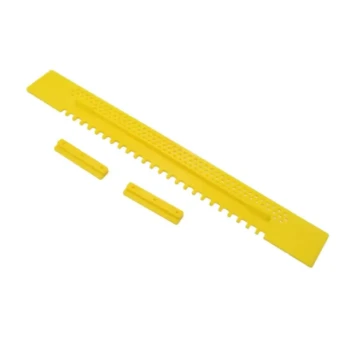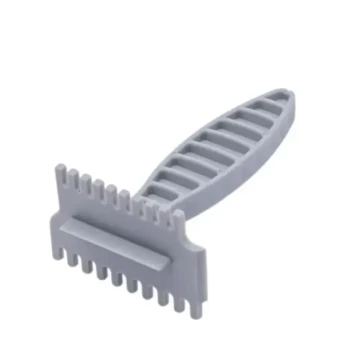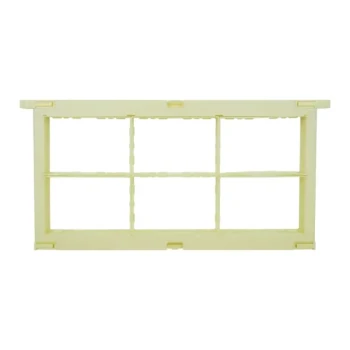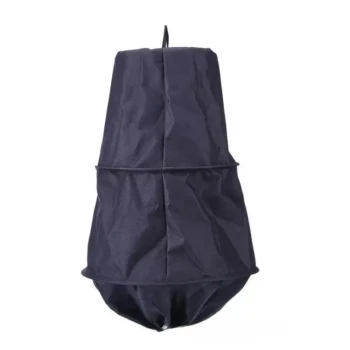The primary argument for leaving attendant bees in a queen cage during introduction is rooted in safety and continuity of care. The attendants feed, groom, and protect the queen during the stressful period of transit and initial placement, while the act of removing them introduces significant, unnecessary risks, including injuring the queen or causing her to be accidentally released before the colony has accepted her.
Successful queen introduction is a critical moment that determines a colony's future. While debates exist, the standard practice is to leave attendants in the cage, as the immediate physical risk of removing them far outweighs the potential for minor social friction they might cause.
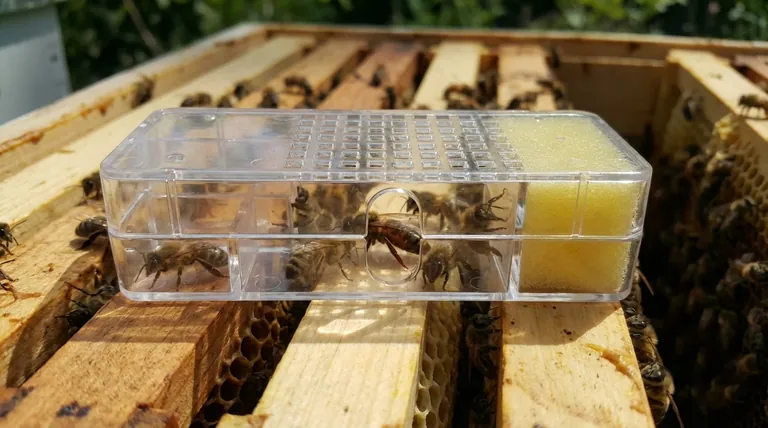
The Core Function of Attendant Bees
When you receive a new queen, she is not alone. The small group of worker bees with her, known as attendants, serve a vital purpose that extends from the queen breeder's apiary to your own.
Ensuring Continuous Care
A queen bee does not feed herself. She is constantly tended to by worker bees who feed her, groom her, and manage her waste.
The attendant bees in the cage perform this function, ensuring she remains well-nourished and healthy throughout shipping and the initial, stressful hours inside a new hive.
A Buffer During a Stressful Transition
The journey and introduction process is incredibly stressful for a queen. The attendants provide a familiar, stable environment inside the cage.
Their presence acts as a small, loyal retinue that reduces her stress, which is critical for her to begin projecting the calm, pheromone-rich presence needed for colony acceptance.
The Risks of Removing Attendants
The primary argument for leaving attendants in the cage is less about their benefits and more about the significant dangers of taking them out.
Danger to the Queen
Attempting to remove the attendants requires opening the cage or trying to fish them out through small openings. This manual intervention is fraught with risk.
You can easily damage the queen's legs or wings in the process. A panicked queen might also injure herself on the cage mesh. Given her value, this is a risk that provides very little reward.
The Threat of Accidental Release
The most common disaster scenario when removing attendants is accidentally releasing the queen.
If you fumble the cage or open it too wide, the queen can fly away or fall into a hostile hive. An uncontrolled release almost guarantees she will be killed by the colony bees, wasting your investment and setting the colony back weeks.
Understanding the Trade-offs
No beekeeping practice is without debate. Objectivity requires acknowledging the argument against leaving attendants in the cage, even if it is a minority view.
The "Foreign Scent" Argument
The main counter-argument is that attendant bees carry the scent of their original hive. Some beekeepers theorize that this foreign scent can increase the new colony's aggression, making acceptance more difficult.
The idea is that removing the foreign attendants forces the host bees to tend to the queen through the screen, accelerating the transfer of scent and pheromones.
Evaluating the Actual Risk
In reality, the pheromonal footprint of a half-dozen attendant bees is minimal. The colony's initial defensiveness is directed almost entirely at the new queen herself, who smells completely foreign.
The cage is designed specifically to manage this primary conflict by allowing for slow scent acclimation. The presence of a few extra workers does not fundamentally change this dynamic, whereas dropping the cage and losing the queen is a catastrophic, unrecoverable error.
When Removal Might Be Warranted
The only time to seriously consider removing attendants is if you inspect the cage upon arrival and find that they are dead or appear to be attacking the queen. This is very rare but can happen.
Even in this scenario, the removal must be done with extreme care, ideally indoors over a large container to prevent the queen's escape.
Making the Right Choice for Your Goal
Your decision should be guided by a clear-eyed assessment of risk versus reward. For the vast majority of beekeepers, the choice is simple.
- If your primary focus is risk mitigation and queen safety: Leave the attendants in the cage. This is the standard, time-tested practice that protects your queen from physical harm and accidental loss.
- If you are an advanced beekeeper with a specific concern: You might consider removing the attendants, but only if you are confident you can do so with zero risk of injury or escape.
Ultimately, a successful introduction depends on giving the queen the safest possible start in her new home, and retaining her attendants is the most reliable way to achieve that.
Summary Table:
| Practice | Primary Benefit | Key Risk Mitigated |
|---|---|---|
| Leaving Attendants | Continuous care & reduced queen stress | Prevents queen injury and accidental release |
| Removing Attendants | (Theoretical) Faster scent acceptance | High risk of injuring or losing the queen |
Ensure every queen introduction is a success with the right equipment from HONESTBEE.
As a trusted supplier for commercial apiaries and beekeeping equipment distributors, we provide the durable, well-designed queen cages and beekeeping supplies you need for safe, efficient hive management. Let our wholesale-focused operations support your business's growth and stability.
Contact HONESTBEE today to discuss your supply needs and place your order!
Visual Guide
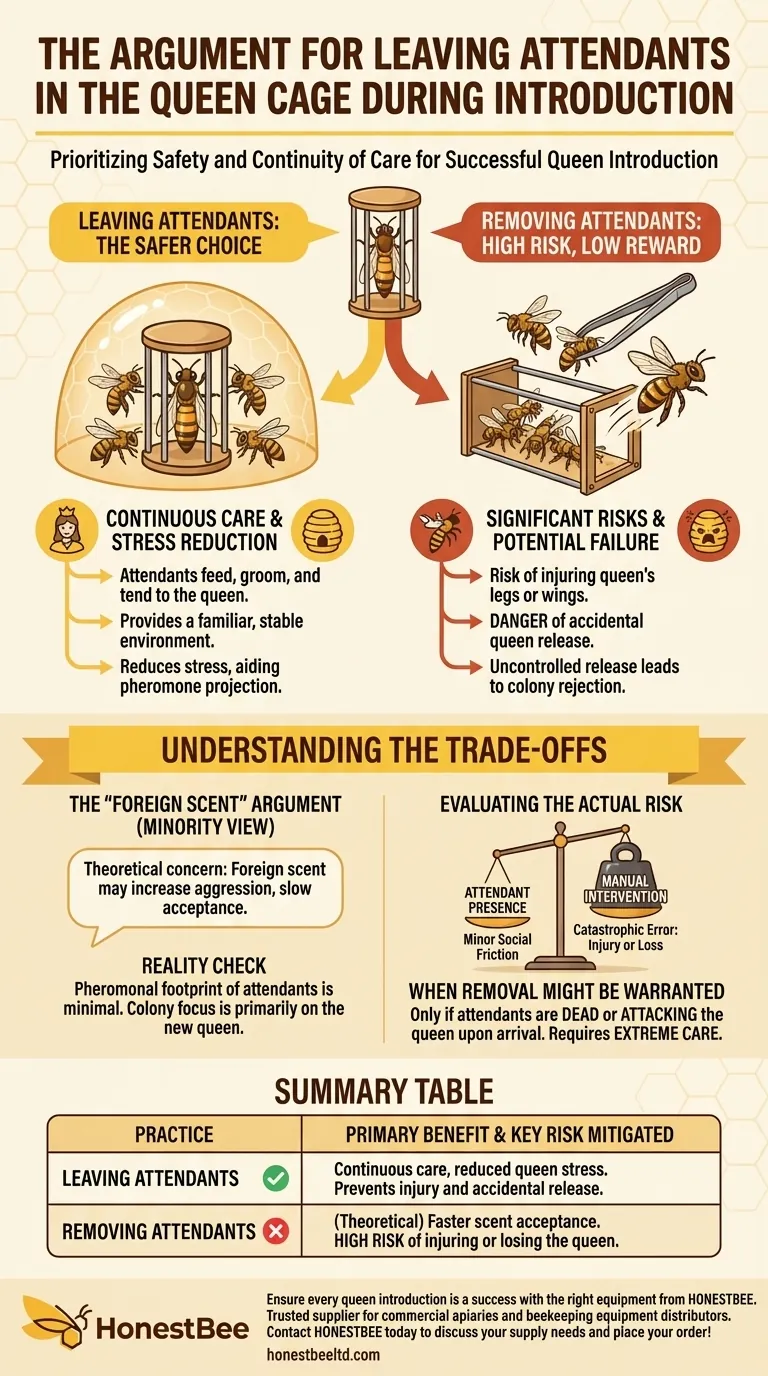
Related Products
- Professional Queen Bee Introduction and Transport Cage
- Durable Galvanized Steel Spring Queen Bee Cage
- No Grafting Queen Rearing Kit: System for Royal Jelly Production and Queen Rearing
- Portable Bee Mating Hive Boxes Mini Mating Nucs 8 Frames for Queen Rearing
- Twin Queen Styrofoam Honey Bee Nucs Mating and Breeding Box
People Also Ask
- What is a Queen Cage and how is it used? Master the Art of Safe Queen Introduction
- What are the advantages of using a nuc box? Achieve Superior Colony Management and Growth
- How do queen cages function to protect queen bees? Ensure a Safe and Successful Queen Introduction
- How should the cell starter (swarm box) be set up? A Step-by-Step Guide to Queen Rearing
- How are mating boxes set up for queen rearing? A Guide to Building a Stable Nucleus Colony
